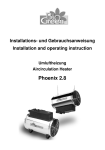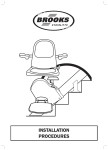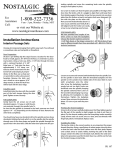Download Window & Door Installation Manual
Transcript
Cl/SfB (31) L41:P51 Window & Door Installation Manual La s t i ng Per for ma n ce T h rough I n novat ion Ti m b er W i n d ow s & D o o r s Xi March 2015 IM-0313 CONTENTS THE ORDERING & DELIVERY PROCESS THE ORDERING & DELIVERY PROCESS Introduction . . . . . . . . . . . . . . . . . . . . . . . . . . . . . . . . . . . . . . . . . . . . . . . . . . . . . . . . . . . . . . . . . . 3 Delivery & Storage . . . . . . . . . . . . . . . . . . . . . . . . . . . . . . . . . . . . . . . . . . . . . . . . . . . . . . . . . . . . . 3 Product Registration & Guarantees . . . . . . . . . . . . . . . . . . . . . . . . . . . . . . . . . . . . . . . . . . . . . . . . . 4 Correct installation is vital to ensure that the product is weatherproof, operates correctly, protects the coating and validates the guarantee. Due to the wide range of construction methods and stages as well as the range of materials on the market, it is impossible to provide an in-depth installation process. Instead this manual is intended as a guide in good practice, identifying the general process, product specific requirements and the recommendation of using good quality materials. RECOMMENDED FIXING SPECIFICATIONS . . . . . . . . . . . . . . . . . . . . . . . . . . . . . . . . . . . . . . . . . . . . . 4 It’s important that you follow the requirements outlined in this manual to ensure that your products meet their performance potential, operate as intended and validate the guarantee. As an alternative the procedures outlined in PRODUCT DAMAGE . . . . . . . . . . . . . . . . . . . . . . . . . . . . . . . . . . . . . . . . . . . . . . . . . . . . . . . . . . . . . . . 4 BS 8213-4:2007 Windows, doors and rooflights – Part 4: Code of practice for the survey and installation of windows and external doorsets can be used. INSTALLATION PROCESS Planning and preperation . . . . . . . . . . . . . . . . . . . . . . . . . . . . . . . . . . . . . . . . . . . . . . . . . . . . . . . . Removing old windows and doors . . . . . . . . . . . . . . . . . . . . . . . . . . . . . . . . . . . . . . . . . . . . . Levelling the cill . . . . . . . . . . . . . . . . . . . . . . . . . . . . . . . . . . . . . . . . . . . . . . . . . . . . . . . . . . . Remove sashes if required . . . . . . . . . . . . . . . . . . . . . . . . . . . . . . . . . . . . . . . . . . . . . . . . . . . . . . . Position frame in opening . . . . . . . . . . . . . . . . . . . . . . . . . . . . . . . . . . . . . . . . . . . . . . . . . . . . . . . Couple frames if required . . . . . . . . . . . . . . . . . . . . . . . . . . . . . . . . . . . . . . . . . . . . . . . . . . . . . . . . Fix frame into opening . . . . . . . . . . . . . . . . . . . . . . . . . . . . . . . . . . . . . . . . . . . . . . . . . . . . . . . . . . Fixing distances . . . . . . . . . . . . . . . . . . . . . . . . . . . . . . . . . . . . . . . . . . . . . . . . . . . . . . . . . . . Direct fix . . . . . . . . . . . . . . . . . . . . . . . . . . . . . . . . . . . . . . . . . . . . . . . . . . . . . . . . . . . . . . . . Straps . . . . . . . . . . . . . . . . . . . . . . . . . . . . . . . . . . . . . . . . . . . . . . . . . . . . . . . . . . . . . . . . . . . Fit any frame components that were supplied loose . . . . . . . . . . . . . . . . . . . . . . . . . . . . . . . . . . . . Refit the sash/door . . . . . . . . . . . . . . . . . . . . . . . . . . . . . . . . . . . . . . . . . . . . . . . . . . . . . . . . . . . . . Adjust the hinges and locks . . . . . . . . . . . . . . . . . . . . . . . . . . . . . . . . . . . . . . . . . . . . . . . . . . . . . . Apply foam around the frame . . . . . . . . . . . . . . . . . . . . . . . . . . . . . . . . . . . . . . . . . . . . . . . . . . . . . Apply mastic if required . . . . . . . . . . . . . . . . . . . . . . . . . . . . . . . . . . . . . . . . . . . . . . . . . . . . . . . . . Fit trims . . . . . . . . . . . . . . . . . . . . . . . . . . . . . . . . . . . . . . . . . . . . . . . . . . . . . . . . . . . . . . . . . . . . . All of our Approved Partner Installers are FENSA approved (FENSA – the government authorised Competent Person Scheme for the replacement of windows, doors and roof lights in England and Wales). If you choose to employ the services of your own installation team then you will need to ensure that they are a FENSA approved contractor; if they are not an approved contractor then you will need to apply to your Local Authority Building Control for permission. 5 5 5 5 5 6 6 6 6 6 7 7 7 7 7 7 In addition, you must check that your installer has a thorough understanding of Building Regulations as it’s a legal requirement to comply. DELIVERY & STORAGE Your windows and doors will be delivered in protective packaging to prevent damage whilst in-transit, during offloading or whilst in very short-term storage. All products should be checked at the time of delivery to ensure that they are in accordance with the order schedule, that the delivery is complete and that no damage has occurred during transit. Upon checking, if any issues are discovered then you should notify us of the problem within 3 days of delivery. REGLAZING . . . . . . . . . . . . . . . . . . . . . . . . . . . . . . . . . . . . . . . . . . . . . . . . . . . . . . . . . . . . . . . . . . . . . 8 PRODUCT SPECIFIC INFORMATION Casement Windows . . . . . . . . . . . . . . . . . . . . . . . . . . . . . . . . . . . . . . . . . . . . . . . . . . . . . . . . . . . . Sash Windows . . . . . . . . . . . . . . . . . . . . . . . . . . . . . . . . . . . . . . . . . . . . . . . . . . . . . . . . . . . . . . . . Tilt & Turn Windows . . . . . . . . . . . . . . . . . . . . . . . . . . . . . . . . . . . . . . . . . . . . . . . . . . . . . . . . . . . Pivot Windows . . . . . . . . . . . . . . . . . . . . . . . . . . . . . . . . . . . . . . . . . . . . . . . . . . . . . . . . . . . . . . . . Entrance & French Doors . . . . . . . . . . . . . . . . . . . . . . . . . . . . . . . . . . . . . . . . . . . . . . . . . . . . . . . . Bi-Folding Doors (Outward Opening) . . . . . . . . . . . . . . . . . . . . . . . . . . . . . . . . . . . . . . . . . . . . . . . Bi-Folding Doors (Inward Opening) . . . . . . . . . . . . . . . . . . . . . . . . . . . . . . . . . . . . . . . . . . . . . . . . . Sliding Doors . . . . . . . . . . . . . . . . . . . . . . . . . . . . . . . . . . . . . . . . . . . . . . . . . . . . . . . . . . . . . . . . . Tilt & Slide Doors . . . . . . . . . . . . . . . . . . . . . . . . . . . . . . . . . . . . . . . . . . . . . . . . . . . . . . . . . . . . . . 10 10 11 12 13 15 18 20 21 When off-loading products from the delivery vehicle or stillages, you should store them vertically in the correct orientation. Ideally products should not be stacked on top of each other. However, should this be necessary due to site conditions then the products should be spaced-off each other to allow for adequate ventilation below each item. Please note, if the spaces below each item are too narrow then the product coating may get damaged. If for any reason you need to delay the installation, please let us know as soon as you can because our standard packaging will not perform as required. If our standard packaging is kept in place for more than a few days then it may cause damage to the high performance microporous coating which takes time to fully cure. If we know beforehand, we can package the products on timber packers and fix them with battens to ensure that they remain separate (please note, this will add to the overall cost). If the installation is delayed after the products have been delivered, please remove the protective packaging and make sure that the products are carefully stored. When stored externally, the products should be raised off ground level to prevent them being in contact with standing water. They should also be covered in a waterproof sheet to protect them from the elements. When stored internally, they should be protected from dirt and damage and adequate ventilation around the product must be maintained. 2 La s t i ng Per for ma n ce T h rough I n novat ion Ti m b er W i n d ow s & D o o r s GEORGE BARNSDALE 3 PRODUCT REGISTRATION & GUARANTEES Planning and preperation Working with experienced partners we are able to offer industry leading manufacturer-backed guarantees. To activate your guarantees you must return the Window and Doorset Guarantee Registration Form, to us, at the George Barnsdale registered address, within 28 days of delivery. Please be aware that your guarantees will only be valid if the instructions within this manual have been followed. RECOMMENDED FIXING SPECIFICATIONS Direct Method Straps Method Cover bead Foam backing rod Alternative timber trim cover stopped 10mm above cill Mastic Mastic Foam backing rod Expanded foam seal All installers should ensure they: • Have received and understood all necessary drawings, survey detail etc. • Carry within their vehicle sufficient fixings, sealants and architraces/trims for the installation. • Ensure the availability of the adequate protective coverings for the immediate vicinity of the installation and all walkways to the area. • Have adequate availability of tools and personal protective equipment. • Protect the safety of the customer and general public where the installation requires portable access equipment for working at height. • Plan to install and seal the new windows and doorsets on the same day that the existing items are removed. • Have in place arrangements for ensuring that when unavoidable circumstances arise, structural openings, windows and doorsets can be made secure and weathertight. • Give the customer sufficient notice of the sequence of installation and for the removal of any furniture, fittings or fixtures that may be damaged during the installation. Removing old windows and doors 1. 2. 3. 4. Expanded foam seal Metal fixing Metal fixing bracket with shims as required Timber trim Measure both the existing structural opening and the new window or doorset to make sure they fit. If you are concerned about any discrepancies, resolve the issue before you start any removal. Ensure that the building structure will not be damaged when removing the window or door and that it is not supporting any part of the building. Remove the window or door whilst ensuring no large forces are applied to the building structure and use timber blocks as contact points if necessary. Safely dispose of the old windows and doors taking extra care to ensure all glass has been cleaned up. Plaster Straps Method Direct Method For more information on our recommended methods for fixing and weather sealing our windows and doors in different applications, please visit www.georgebarnsdale.co.uk/maintanence. On this web page we are continuously updating our guidance for installation in different applications and utilising the latest building materials. PRODUCT DAMAGE If during the installation of the windows or doors, the product coating is damaged in any way it is vital to repair it immediately to protect the timber. The maintenance instructions within the Window & Door Owner’s Manual provides detailed information on how this should be done. If any other damage is caused, or the coating damage is beyond repair, please contact us on 01775 832000 and we will work with you to find a remedial solution. 4 Levelling the cill It is vital that a replacement window or door is fitted onto a solid and level cill. To achieve this: 1. 2. Remove any loose debris from the cill and ensure that the remaining material is in good repair. If the cill is not level, apply packers on a bed of mastic sealant at intervals of no more than 450mm (centre to centre). The packers must be capable of supporting the load, be resistant to rot and provide as much contact area as possible. The packers should be a maximum of 150mm thick. IMPORTANT: It is recommended that the packers are set to provide the same spacing between the top and bottom of the window or door. Products with extended cills, particularly door cills, will need properly supporting underneath. Failure to do this will result in the joint between the frame and cill, or the frame itself, cracking when subjected to a load. Remove sashes if required INSTALLATION PROCESS It is often simpler and safer to install the frame with sashes/doors removed. If this is the case, sashes and doors can be removed by following the instructions that are outlined in the product specific information pages (from page 10). IMPORTANT: Please read the product specific information (from page 10) to understand any specific requirements. Position frame in opening Certain products have additional requirements to the installation process that is outlined below. These additional requirements are detailed in the product specific information sections of this manual. We advise that you read the following installation process first to ensure that any additional requirements are clear. Insert the frame into the opening and level using wedges if required. Wedges should be used in the corner or within the corner connection to ensure that the frame remains square. It is vital that the products are fitted level and plumb within the opening. La s t i ng Per for ma n ce T h rough I n novat ion Ti m b er W i n d ow s & D o o r s GEORGE BARNSDALE 5 Couple frames if required Fit any frame components that were supplied loose If more than one frame is being fitted in the opening, the frames should be connected using joining strips fixed in with a mastic seal along its length. This can either be done outside of the opening or by placing one frame in the opening with a bead of mastic in the jointing groove, sealing the joining strip into the second frame and then placing the second frame into the opening allowing the joining strip to engage with the first frame. The frames should then be packed off in the opening as per the following section and then joined before the overall frame is fixed to the building. Certain components are supplied loose to allow easier handling and/or installation. These should now be fitted to the frame using appropriate fixings. The joining grooves have been designed in such a way to allow frames to be aligned on the inside or the outside, even when different frame thicknesses are specified. If there are different frame thicknesses specified the exposed outer frame should always be finished with a covering trim. Fix frame into opening Bay window cill extensions are normally supplied separately. They are specially bonded together to avoid splitting on the joints. It is very important not to stress these joints when fitting them to the frames. Apply a bead of Remmers MS150 between the upper frame groove and the cill extension. Fix the cill to the frame using wood screws but only lightly tighten. The connection must allow slight movement between the cill and frame. Make sure the cill is adequately packed underneath prior to sealing. Apply Sealant Secure packing material 30±5 Front face of brickwork If the paintwork is damaged during the fitting of these components, it should be repaired using the process described in the recoating section of the Windows & Doors Owner’s Manual. Fixing distances Head and cill fixing is required in the following cases: 1. The product information in this manual specifies it. 2. The window or door exceeds 1800mm in width. 3. Coupled frames are being fitted. 4. A structural engineer has requested it. Additional fixings for windows >1800mm wide If the cill extension has to be cut around the brickwork exposing bare timber, please ensure this area is repaired according to our remedial instructions. For bay windows it is vitally important not to stress the joints of the cill by altering the angle of the bay windows. 150mm IMPORTANT: Do not allow any cill to protude more than 35mm without adequate support. 150450mm mm Weight 450mm For all fixing methods use the diagram opposite to understand the number and position of the fixing points. Refit the sash/door 150mm The sash/door can now be refitted according to the product specific information instructions. Fixing locations Vertical Sliding Sash pinched due to oversize middle packs 150 mm Weight Adjust the hinges and locks Weight It is vital for easy operation and long term performance that the hinges and locks are correctly adjusted at this stage. The procedures are detailed for each product in the product specific information section (from page 10) . Vertical Sliding Sash could fall out if sides of frame are not correctly fitted Vertical Sliding Sash pinched due to oversize middle packs IMPORTANT: This process may need to be repeated after a few days/weeks/months to counteract any movement from the sash/door settling into the correct position. 150 mm Weight Weight Apply foam around the frame Direct fix Straps 1. 1. 2. 3. 4. 5. 6 Fit packers at the screw points to fill any gap between the wall and the frame. Drill through the frame and packer deep enough to allow 25mm of fixing engagement into the building structure (it is recommended to allow 50mm). Offset these drill holes (across the depth of the frame) to provide a more solid fixing and prevent twisting. Fit a suitable fixing plug into the building structure and fit the screw. Check the frame is true, plumb and has no twisting. Repair any damage to the coating using the process described in the recoating section of the Windows & Doors Owner’s Manual. Vertical Sliding Sash could fall out if sides of frame are not correctly fitted 2. 3. 4. 5. Select straps suitable for external installation of windows and doors that are the correct Weight specification for the size and weight of the product. Fix the straps to the frame at intervals as defined above, predrilling the frame for each screw. Ensure that the fixing points line up with a sound part of the building structure and do not line up with mortar joints or other weak points. Fit a suitable fixing plug into the building structure and fit the screw. Check the frame is true, plumb and has no twisting. Repair any damage to the coating using the process described in the recoating section of the Windows & Doors Owner’s Manual. La s t i ng Per for ma n ce T h rough I n novat ion Ti m b er W i n d ow s & D o o r s If required, apply the foam according to the fixing specification method you have chosen and the manufacturer’s instructions. Foam continues to expand after it has been applied and care must be taken not to over apply the foam as this can result in distortion of the frame (especially on deeper frames such as those found on sash windows and patio doors). Apply mastic if required Apply the mastic, if required, according to the fixing specification method you have chosen and the manufacturer’s instructions (do not use silicone). A closed cell backing rod should be applied first which gives the mastic a surface to adhere to and prevents it falling into the cavity. RECOMMENDED PRODUCT: We recommend Sika Hyflex 250 facade or Arb MP10. Fit trims The window or door is now ready to be finished with any required trims. If we have supplied these trims, ensure that any damage to the coating is repaired according to our remedial instructions. For other trims, follow the manufacturer’s instructions. GEORGE BARNSDALE 7 REGLAZING 9 10 Most of our windows and doors are glazed with a drained and ventilated system with internal beads. This enables a good coating performance, allows the glazed unit to have a long life and provides excellent security. If a glazed unit is damaged and requires replacement, please follow the procedure outlined below. Where astragal bars are present, these should be treated and re-fixed in a similar manner to the frame/beading on their respective face. IMPORTANT: If the sash or door is in a unit that can be removed from the frame then the following process is easier: 1 Use a glazing shovel to carefully ease out the glazing bead. 3 4 Once the glazing bead has been detached, remove any pins from the beading or sash frame. 6 Use either a Fein tool or a craft knife to cut through the external seal. A glazing shovel should be used to increase the gap, to ensures the blade does not damage the paintwork. 7 8 Separate the glass unit from the sash frame and place to one side. Remove any residual bonding tape and sealant from the sash frame, W i n d ow s & D o o r s If reusing a glazing unit, residiual tape must be cleaned off this too. 14 Use the original packers to align the glass unit in place before removing the backing from the new bonding tape. Once happy with the fit, remove the tape backing and fit the glass unit in place. Ensure the glass is fully bedded on the glazing tape. 16 It may be necessary to use a glazing shovel to gently move the glass unit to allow for the placement of the packers. 17 La s t i ng Per for ma n ce T h rough I n novat ion Ti m b er Allow approximately 3mm of overlap which will be trimmed back later. 15 Once all the seals have been cut, prise the glass unit away from the sash frame using a glazing shovel. Once all the old bonding tape has been removed, apply new tape face down. 12 13 Break the seal between the glass unit and frame and then flip the sash over to begin work on the external face. 5 8 11 2 Use either a Fein tool or a craft knife to cut through the seal on the internal bead. Whilst most of the bonding tape should be removable by hand it may be necessary to use a blunt tool to carefully remove the tape, being careful not to damage the paintwork. Before re-applying the internal beading apply a strip of silicone to the gap between the glass unit and the sash frame at the bottom and 100mm up the sides. 18 Re apply the internal beading using pins and BLUE TAPE to secure the strips in place. Carefully cut away the excess overlap of bonding tape, to avoid moisture build up on the bottom edge, cut at an angle that follows the profile of the sash frame. GEORGE BARNSDALE 9 PRODUCT SPECIFIC INFORMATION The following information provides specific details on how to install your windows and doors. CASEMENT WINDOWS Cords and weights (S1): The sash can be pulled out of the frame, exposing the point at which the cord is screwed to the sash. The cord (shown in grey) can then be unscrewed on each side allowing the sash to be removed. IMPORTANT: Ensure the cord is not pulled through the pulley into the frame by tying a knot at the end. Spiral balance (S2): Raise the sashes as high as possible and prop up. Unscrew the balance foot attachment on the underside of the bottom rail. Unfold foot attachment. Unscrew the balances from the jamb and remove. (C1/C2/C3/C4) Installation Casement windows can be installed according to the standard installation instructions and have no specific requirements. Sash removal/refit To aid installation it is possible to remove the sashes and refit them afterwards. To remove the sash, first open it and remove the screws that attach the hinge to the frame (using an R1 square drive), ensuring that the sash is well supported at all times. Refitting is the reverse of the removal process. SASH WINDOWS Tilting Mechanism (S3): Undo the tilt catches to allow the sash to tilt forwards. Detach the restrictor by pressing the spring clip and sliding the arm free (as shown in the opposite diagram). Unscrew the quick release arm at the bottom of the base. TILT & TURN WINDOWS & DOORS (E1/DS11) (S1/S2/S3) Installation Installation Our traditional box sliding sash windows (S1) have been tested to BS6275 Pt1 and have got very good air penetration performance. However care must be taken when fitting them to ensure there is no air leakage from the cavity as the box is not sealed on the outer side. Depending on the position of the air seal will depend on where an EDPM may be required. Our tilt and turn windows are fully adjustable. In the unlikely event the sash weighs over 100kg a load transfer device will also be fitted, please contact us for instructions on how to adjust this. Sash removal/refit To remove the sash follow the procedure below. Refitting is the reverse of the removal process. Please speak to our Technical Department if you are in any doubt. Sash removal/refit It is not advised to remove sashes once they are fitted. If the size/weight of the sashes are an issue then we recommend that the windows are requested to be supplied with the sashes loose. If the sashes are supplied loose, please refit as detailed below. To remove a sash on all variations of a sash window, you must first remove the box bead on the inside of the frame (it is only necessary to remove it on the sides). The box bead is pinned onto the window and can be removed by carefully levering it loose with a chisel or similar tool. Once the bead is removed the sashes can be detached according to the balance type - please see type details on the opposite page. Bring the handle into the tilt mode and open. 10 La s t i ng Per for ma n ce T h rough I n novat ion Ti m b er W i n d ow s & D o o r s Press down the lifting mishandled device (if mounted). Bring the handle into the turn mode and secure the sash manually or with mechanical support. GEORGE BARNSDALE Whilst supporting the sash lift it upwards, slightly tilted open. 11 ENTRANCE & FRENCH DOORS Adjustments The sash can be adjusted in multiple ways to ensure that it opens smoothly and closes tightly, adjustments can be made to the sash stays and corner hinges as shown in the diagrams below: (DS2/DS3/DS5/DS6) Installation Frame installation Sash Stay Adjustments It is important to ensure that the doorset is installed with good fixing around the hinge and locking points - please follow the general installation procedures, making sure that fixing points are positioned in these areas. Doors should also be supported by durable packers no greater than 150mm on the head and cill, at 450mm centres. Horizontal Adjustment +/-2.0 If the door frame is fitted with an extended cill it is important to check that it is adequately supported as shown in the diagram opposite. Compression Adjustment +/-0.5 Pivot Hinge Adjustments Packer Mastic Joint 30±5 Front face of brickwork IMPORTANT: Do not allow any cill to protude more than 35mm without adequate support. It is even more essential that patio doors are installed plumb and square. Any error will be magnified due to the size. It is also very important that there are adequate fixings across the frame head. Sash removal/refit Horizontal Adjustment +2.0/-1.5 Height Adjustment +1.5/-1.0 Compression Adjustment +/-0.5 The hinge pins have been left loose on both our standard and stable door flush hinges, this allows removal of the pins to separate the sash and frame for ease of installation. Once the door has been installed into the opening, the pins should be knocked in fully using a soft headed mallet. In the event you need to remove the sash these pins can be knocked out again from below. Keep adjustment PIVOT WINDOWS Most keeps we supply are fully adjustable. When the hinges have been adjusted, the keeps should be adjusted. (P1) Striker Plate: Should be adjusted to allow the door to latch shut but not so that it is necessary to slam it shut. Use a T15 torx to adjust the compression on the gasket by turning the eccentric cam located at the top and bottom of the adjustable striker plate. Hook Bolt Plates: Should be adjusted so that when the bolts are engaged it holds the stile true and against the seals. The seals will force the stile of the door away from them and it is important to stop the door warping to keep the stile true. Use a T15 torx to adjust the compression on the gasket by turning the eccentric cam located at the top and bottom of the adjustable hook bolt plate. Installation Sash removal/refit The sash can be simply removed on both the surface Tilt-depth regulator: tilt depth at mounted and flush type hinges. The 90mm sash should this adjustment be opened until the screw is visible (see opposite diagram). This screw should be removed from both hinges allowing the sash to be lifted off the hinge. Replacing the sash is the reverse of the above process. IMPORTANT: Do not adjust with a power tool, hand tool adjustment only. 12 La s t i ng Per for ma n ce T h rough I n novat ion Ti m b er W i n d ow s & D o o r s GEORGE BARNSDALE 13 Hinge adjustment BI-FOLDING DOORS (OUTWARD OPENING) Most hinges we supply are fully adjustable. When the fitting is complete please check that the door is true and square in the frame with an equal gap. The standard hinges can be adjusted vertically and horizontally as shown in the series of diagrams below: Installation (DS17) Frame installation IMPORTANT: Do not adjust with a powertool, hand tool adjustment only. Flush Door Hinge (Standard) Concealed Hinge All Adjustments The horizontal and the vertical adjustments are to be carried out without unhanging the door. Open the door by approx. 90 o and adjust the sash vertically (+/- 3mm) by turning the “V” screw in the middle hinge. Adjust the sash horizontally (+/- 2mm) by turning the “H” screws in the upper and the lower hinge. B G C E D F A H Horizontal Adjustment Tighten or loosen screws C and D to increase or decrease the air gap +/- 3mm. Height Adjustment Loosen screw A by at least 3 turns, then tighten or loosen screw B to alter the height of the sash +/- 3mm. Lock by tightening screw A. Compression Adjustment Loosen screws G and H. Tighten or loosen screws E and F to alter the compression +/- 1mm. Lock by tightening screws G and H. It is even more essential that patio doors are installed plumb and square. Any error will be magnified due to the size. It is also very important that there are adequate fixings across the frame head. It may be necessary to check with a structural engineer that the lintel above is capable of carrying the weight. The cill also needs to be adequately supported and packed across the whole length and depth. It is important to ensure that the frame is fixed according to the maximum track fixing centres (as shown below). Install frame If the frame is fitted with an extended cill it is important to check that it is adaquately supported (as shown on page 13). Flush Door Hinge (Stable Door) Unlock the hinge The adjustment is to be carried out without unhanging the door. Open the door by approx. 90 o and fix it by wedging. Loosen the two central clamping screws of each hinge. 14 Height & Compression Adjust the height (+/-3 mm) and the compression (+/- 2 mm) of the door leaf by moving the sash in the appropriate directions. Lock the hinge Tighten the clamping screws and remove the wedges. La s t i ng Per for ma n ce T h rough I n novat ion Ti m b er W i n d ow s & D o o r s Horizontal Adjustment Adjust the horizontal position (+/- 2 mm) by turning the upper and the lower screw of each hinge. Bi-parting sets only Front alignment Maximum track fixing centres Track fixing and carrier clearance GEORGE BARNSDALE 15 Sash removal/refit Magnetic door catch The magnetic door catches are supplied loose and should be fitted to the doors once they have been installed and adjusted to ensure that they line up accurately. The location of the door catch is recommended as in the opposite diagrams. Ensure there is enough clearance for door furniture. Adding panels Fitting pivot panel Adjustments To install the magnetic door catch, the following process should be adhered to: 1. Assemble the door catch in the order shown. Ensure the springs remain in place. 2. To accurately position the door catch onto the door panel, cut out the door catch template (see Appendix B, page 23) for Step 3. The template below is for illustrative purposes only and not to scale. 3. Mark the doors with the desired location of the door catch. Line up the template (see Step 2) and mark the screw holes. 4. Drill the screw holes. 5. After pre-drilling the screw hole, fix the set onto the door panel as shown. Add the cover, ensuring that the clip is through the slots on each side. 6. If you ever need to remove the door catch, you will need to push the clips in on both sides and remove the cover from the base. Unscrew the screws to remove the door catch from the door panel. Vertical and horizontal adjustment can be made on the hinges to allow for any movement after installation. Vertical Adjustment Horizontal Adjustment Insert the shipping clip (as shown in the diagrams below) and adjust using a flat headed screwdriver. Once the adjustment has been made, remove the shipping clip. Using a flat headed screwdriver adjust the horizontal screws found in the top and bottom rollers (as shown in the diagram below). Turning the screws clockwise will increase the gap between the frame & sash, turning anti-clockwise will reduce the gap. Vertical adjustment - Hinge locations Horizontal adjustment - Roller locations IMPORTANT: Ensure the shipping clip is kept safe for any future adjustments. 16 La s t i ng Per for ma n ce T h rough I n novat ion Ti m b er W i n d ow s & D o o r s GEORGE BARNSDALE 17 Hold Back Magnets Support-bracket with guide roller 1. Insert the guide roller into the track and position to the support-bracket. 2. Tighten the lock-nut with a 17mm open-ended spanner. For intermediate panels we also supply an additional set of magnetic catches (1 pair as standard and 2 pairs if the door is over 2250mm high). These should be fitted to the bottom of each intermediate panel (and also to the top if a second pair is supplied) as shown in the opposite diagram. IMPORTANT: Ensure there is enough clearance for door furniture. Adjustments BI-FOLDING DOORS (INWARD OPENING) (DS16) Installation Adjustment of the door spacing 1. Open the door to expose the hinge that requires adjusting. 2. Adjust the hinge by turning the centre head bolt using a 4mm Allen key. Frame installation It is even more essential that patio doors are installed plumb and square than normal doors. Any error will be magnified due to the size. It is also very important that there are adequate fixings across the frame head. Sash installation/removal Installation to frame 1. Join the frame hinge-bearing and hinge in the opened sash position by inserting the cylindrical pin. 2. Secure the cylindrical pin with the countersunk screw. 18 Installation to sash 1. Join the sash hinge-bearing and hinge in the opened sash position by inserting the cylindrical pin. 2. Secure the cylindrical pin with the countersunk screw. La s t i ng Per for ma n ce T h rough I n novat ion Ti m b er W i n d ow s & D o o r s Adjustment of the sash via the roller 1. Remove the cover cap. 2. Loosen the lock-nut with a 17mm open-ended spanner. 3. Carry out the height adjustment by turning the threaded bolt using a 4mm Allen key. 4. Tighten the lock-nut again. GEORGE BARNSDALE 19 SLIDING DOORS TILT & SLIDE DOORS (DS13) Installation Installation Frame installation Frame installation It is even more essential that patio doors are installed plumb and square than normal doors. Any error will be magnified due to the size. It is also very important that there are adequate fixings across the frame head. It is even more essential that patio doors are installed plumb and square than normal doors. Any error will be magnified due to the size. It is also very important that there are adequate fixings across the frame head. Sash removal/refit Sash removal/refit When installing Sliding Doors ensure the cill is level. The rubber end stops will be installed as standard. 1. 2. 3. 1. 2. 3. 4. Adjustment 2 IMPORTANT: The doors will not align in the cill is not level. If the door frame is fitted with an extended cill it is important to check that it is adequately supported. Installing the rear side stop plate (top). Installing the rear side stop plate (bottom). Installing the front side track guide. La s t i ng Per for ma n ce T h rough I n novat ion W i n d ow s Test the parallel positioning in the sliding direction, and adjust if necessary. Loosen the clamping-screw for the connecting rod (as shown in the opposite diagram) on the leading roller, align the sash parallel and tighten the clamping-screw firmly. After the operating test, tighten up both guide block screws firmly. Packers Ti m b er Loosen the clamping screw on the scissors-slider. Slide scissor-slider out of the stay-connecting profile. Place the sash at the 30 degree angle and lift out of the bottom roller track. 1 Remove all stop plates and front side track guide. Move the handle into the ‘sliding position’. Offer the sash into the top track then position the sash on the bottom roller track. Re-attach all stop plates and front side track guide Removal is the reverse of the fitting process. 20 (DS12) & D o o r s Clamping-screw for connecting rod SW Leading roller 4 Trailing roller APPENDIX A - A Summary of our Product Guarantees APPENDIX B - Template for Door Catch Positioning Coating Guarantees Our windows and doors are supplied with a 10 year guarantee for paint finishes and a 7 year guarantee for stain finishes, with no redecoration required. The guarantee life is affected if the windows are installed in areas of high exposure (for example, near the coast or at high altitude). For further details on this, please see the Coating System Guarantee brochure. To get the most out of the coating system and meet the requirements of the guarantee, it’s important to install and maintain the product in accordance with the instructions contained within this manual. Glazing Guarantee Our windows and doors are supplied to an enhanced visual quality standard that exceeds the Glass and Glazing Federation’s visual quality standard for installed insulating glass units constructed from flat transparent glass, which is the standard across the industry. Our enhanced standard is available on our website at www.georgebarnsdale.co.uk/visual-quality-standard All drained and vented units have a 10 year manufacturer-backed guarantee against any premature failure of the perimeter seal. This is a guarantee for supply and fit in the first five years and supply only for the remainder. The guarantee covers failure of the unit due to manufacturing faults and does not cover damage resulting from failure to follow the maintenance guidance. Some Historic Range units will have a reduced guarantee - see our Historic Range brochure for details. Any other units specified due to a special request will have no guarantee unless stated. APPENDIX C - Recoating Guidelines Instructions for recoating to achieve a colour change from original factory finish In order to change colour from the original factory finish to achieve a different colour on site, we advise that the method detailed below is used: 1. All surfaces require a thorough clean before any coating application takes place. This is best achieved using a mild detergent, but if any mould or algae has taken hold it is best to treat affected areas with one part household bleach to two parts water. After 20 minutes this treatment should be rinsed with clean water. When surfaces are clean and dry the recoating work can begin. 2. Lightly abrade newly applied coatings (anything older than 72 hours) with a p240 grade abrasive, taking care to follow the line of the grain. Remove all sanding dust prior to any coating application. 3. Apply a full coat of Remmers Compact Opaque PU. Always use a high quality nylon bristle brush for the application of the water based products. Apply first across and then along the grain of the timber. The application rate should be around 70-80ml/m² which equates to a wet film thickness of 70-80µm (microns). Allow to dry for a minimum of 3-4 hours. This will be longer in colder and still conditions (under 15oC). Do not apply when the temperature is below 10 oC. 4. If the colour of the existing coating is grinning through apply a further coat of Remmers Compact Opaque PU using the same procedure as above. Hardware Guarantee All hardware is supplied with a 10 year guarantee against functional failure. This guarantee is for supply and fit in the first year and supply only for the remainder of the guarantee, with the exception of spring balances, which are covered by 5 years supply and fit and supply only for the remainder. The guarantee relies on the product being operated and maintained correctly and does not cover the surface finish of any hardware. The hardware forms a vital part in keeping the sashes and doors fitted squarely and restricting timber movement and, as such, must be installed, operated and maintained in accordance with the instructions detailed within this manual. This is especially true of doors, which must be kept in the bolted position when closed. All windows and doors are fitted with multipoint locking systems as standard providing excellent support and security. Weather Seals Guarantee Our products are supplied with advanced weather seals that enable us to achieve exceptional levels of weather proofing. All seals are provided with a 10 year guarantee against failure of the protective coating. This is a guarantee for supply only as, in the unlikely event of a failure, the replacement is a simple process that does not require tools. 22 La s t i ng Per for ma n ce T h rough I n novat ion Ti m b er W i n d ow s & D o o r s PLEASE NOTE: It is vital that a compatible moisture vapour permeable finish is used. Also every care must be taken not to apply more coating than is necessary to get the desired colour. Significant increases to the dry film build will make the whole coating system less permeable which makes it less likely for any moisture that finds it’s way into the system to escape through the micro-porous paint film. GEORGE BARNSDALE 23 Tel: 01775 823000 | Fax: 01775 823010 Email: [email protected] | Web: www.georgebarnsdale.co.uk © George Barnsdale & Sons Ltd 2015. All Rights Reserved. No part of this publication may be reproduced in any form without prior written permission of George Barnsdale & Sons Ltd. Whilst every effort has been made to ensure that this brochure is correct, George Barnsdale & Sons Ltd cannot be held responsible for any omissions or errors. Due to continuous development of the product range we reserve the right to make changes to the specifications without prior notice.



























